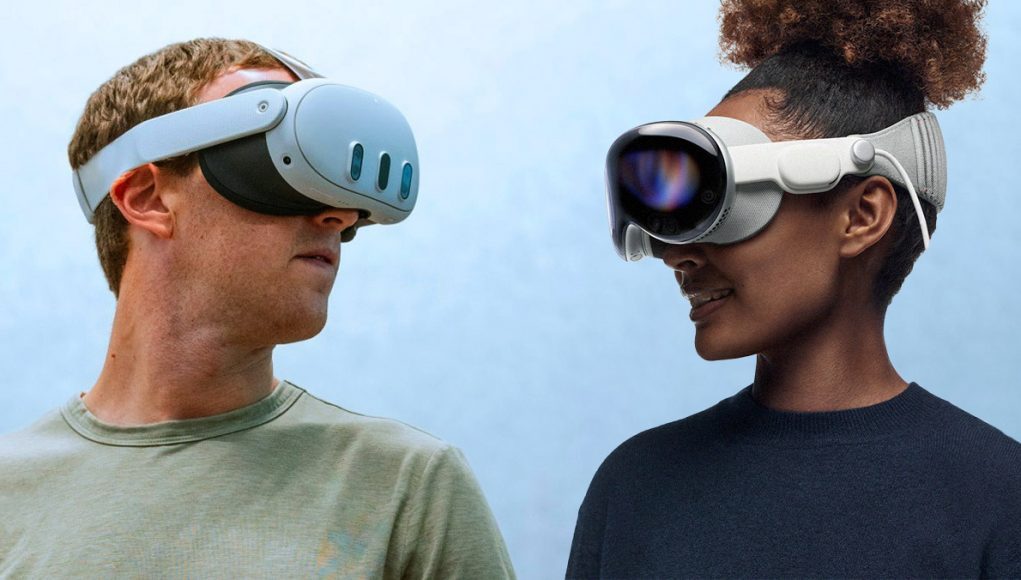Meta has undeniably been the lone looming Goliath in a field of smaller Davids in the XR scene for years now. With Apple finally making its entrance into the market, Meta won’t be able to go at its own pace.
Apple’s new headset might be an absurd $3,500, putting it in a completely different class than Meta’s upcoming Quest 3 at $500, let alone the Quest 2 now at $300. But the pressure will still be on as comparisons are made between the experience Apple has crafted and what Meta offers.
After all, there’s no denying that while the Vision Pro is packed full of hardware, and has the benefit of Apple’s proprietary and powerful M2 chips, so much of what the headset is doing right is about the software experience rather than the fidelity that’s unlocked with the hardware.
Great Hardware, Struggling Software
The thing is, Meta’s headsets are plenty capable. Quest 2 is still a solid product that is in many ways still best in class and Quest 3 only promises to up the ante later this year with more power, higher resolution, improved lenses, and better passthrough AR. Meta’s hardware has always been quite impressive, even as far back as the original Oculus Rift CV1.
But on the software side the company has seriously struggled to make usability a priority. For all the lessons the company learned about the power of reducing friction in VR—by building a standalone headset that doesn’t need a computer or external tracking beacons—there has been seemingly little emphasis on making the same reduction in friction by creating a cohesive interface between Quest’s system interface, and Meta’s own first-party apps; let alone providing a set of clear and useful guidelines so that developers and users alike can benefit from a common user experience.
Lean on Me
Meta has leaned substantially on third-party developers to make using its headsets worthwhile to use. Game developers have done the painstaking work of refining how users should control their apps and interact with their worlds in entertaining ways. When you’re inside of a VR game, the developer is fully controlling the experience to make it cohesive and enjoyable, while sussing out the pitfalls that would turn off users—like bugs, convoluted menus, and inconsistent interactions.
If Meta’s headsets didn’t have games—but still did everything else they’re capable of—they would be dead in the water because of how painful it can be to use the headset outside of carefully crafted game experiences designed to entertain. On the other hand, Apple Vision Pro has a minimal emphasis on gaming (at least at the outset), but is spending significant effort to make everything else the headset does easy and consistent. By doing so, Apple is ensuring that the headset will be great for more than just gaming.
Despite the price difference between Vision Pro and Quest headsets, Meta is still going to have to stare this thing in the face and come to grips with what it could be doing better—for users, developers, and itself. The good news, at least, is that much of the room for improvement is in the software side of things.
The Vacuum
Until now, Meta has had no serious competition in this space. Its headsets—despite the criticisms I’ve laid out here—have consistently offered the best value in their class, with great hardware and a great game library, all at a very attractive price that others have largely been unable to match.
That’s made it hard for other headset makers to compete and left Meta little need to respond even if other companies do something better or innovative. It’s also meant that developers and users have very little leverage over what Meta decides to do—after all, where else are they going to go if they want an affordable standalone headset with the best library of content?
Meta has been able to create a vacuum in the consumer VR space which on the surface might look like success… but in reality, it has left Meta unfocused on what it needs to do to make its headsets appeal to a broader audience.
Better for Everyone
Now we have Apple in the game, ready to challenge Meta on hardware and the software experience. Price advantage is clearly in Meta’s favor, but it’s going to need to up its game, otherwise it risks losing not just customers, but more importantly developers, who might see greener grass on the other side—especially if they’re looking forward to a future where Apple’s headset comes down in price.
Apple’s entrance into the market might seem like a threat, but ultimately Meta now gets to sit back and examine all the hard work Apple has done over the years, then choose the best ideas to incorporate into its own offerings, while ignoring what it sees as missteps by Apple.
In the end, Apple’s headset is going to force Meta’s headsets to get better, faster. And that’s good for everyone, including Meta.







